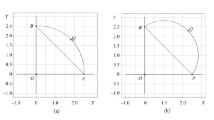Abstract
Consideration was given to planning the optimal evasion trajectory of a moving object from the system of observers consisting of a sensor and initial and terminal points of the route. An optimization criterion was proposed. The optimal trajectory and the speed mode of the moving object were determined for sector and ring—the two zones of search for the maneuvering search means.
Similar content being viewed by others
References
Voronin, A.N., Yasinskii, A.G., and Shvorov, S.A., Design of Compromise-optimal Trajectories of Mobile Robots in a Conflict Medium, Probl. Upravlen. Inform., 2002, no. 2, pp. 12–18.
Cacceta, L., Loosen, I., and Rehbock, V., Computational Aspects of the Optimal Path Problem, J. Ind. Manag. Opt., 2008, vol. 4, no. 1, pp. 1–11.
Zabarankin, M., Uryasev, S., and Pardalos, P., Optimal Risk Path Algorithms, in Cooperative Control and Optimization, Murphey, R. and Pardalos, P., Eds., Dordrecht: Kluwer,2002, vol. 66, pp. 271–303.
Andreev, M.A., Miller, A.B., Miller, B.M., et al., Planning the Trajectory of Unmanned Flight Vehicle under Complicated Conditions and in the Presence of Threats, Izv. Ross. Akad. Nauk, Teor. Sist. Upravlen., 2012, no. 2, pp. 166–176.
Galyaev, A.A., Evasion on Plane from a Single Mobile Observer in the Conflict Environment, Autom. Remote Control, 2014, vol. 75, no. 6, pp. 1017–1024.
Galyaev, A.A. and Maslov, E.P., Optimization of the Law of Moving Object Evasion from Detection under Constraints, Autom. Remote Control, 2012, vol. 73, no. 6, pp. 992–1004.
Galyaev, A.A., Maslov, E.P., and Rubinovich, E.Ya., On a Problem of Control of Object Motion in Conflict Environment, Izv. Ross. Akad. Nauk, Teor. Sist. Upravlen., 2009, no. 3, pp. 130–136.
Abramyants, T.G., Maslov, E.P., and Yakhno, V.P., Mobile Object Evasion from Detection by a Group of Observers, Autom. Remote Control, 2011, vol. 72, no. 7, pp. 1527–1536.
Abramyants, T.G., Galyaev, A.A., Maslov, E.P., et al., Optimization of Evasion of a Marine Underwater Object from Deterction in the Refracted Medium, in Proc. Navy Polytechnical Inst. (VMPI), St. Petersburg: VMPI, 2013, no. 1, pp. 7–20.
Abramyants, T.G., Galyaev, A.A., Maslov, E.P., et al., Evasion of a Moving Object from Detection by a System of Heterogeneous Observers in the Threat Environment, Autom. Remote Control, 2017, vol. 78, no. 4, pp. 714–723.
Author information
Authors and Affiliations
Corresponding author
Additional information
Original Russian Text © A.A. Galyaev, E.P. Maslov, V.P. Yakhno, T.G. Abramyants, 2017, published in Avtomatika i Telemekhanika, 2017, No. 8, pp. 113–126.
This paper was recommended for publication by O.A. Stepanov, a member of the Editorial Board
Rights and permissions
About this article
Cite this article
Galyaev, A.A., Maslov, E.P., Yakhno, V.P. et al. Evasion of a moving object from detection by a system of observers: Sensor–maneuvering search means. Autom Remote Control 78, 1449–1459 (2017). https://doi.org/10.1134/S0005117917080069
Received:
Published:
Issue Date:
DOI: https://doi.org/10.1134/S0005117917080069



